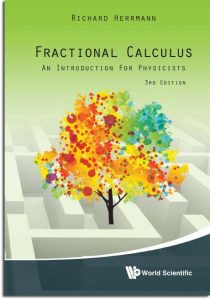
From the cover:
The book presents a concise introduction to the basic methods and strategies in fractional calculus which enables the reader to catch up with the state-of-the-art in this field and to participate and contribute in the development of this exciting research area.
This book is devoted to the application of fractional calculus on physical problems. The fractional concept is applied to subjects in classical mechanics, image processing, folded potentials in cluster physics, infrared spectroscopy, group theory, quantum mechanics, nuclear physics, hadron spectroscopy up to quantum field theory and will surprise the reader with new intriguing insights.
This new, extended edition includes additional chapters about numerical solution of the fractional Schrödinger equation, self-similarity and the geometric interpretation of non-isotropic fractional differential operators. Motivated by the positive response, new exercises with elaborated solutions are added, which significantly support a deeper understanding of the general aspects of the theory.
Besides students as well as researchers in this field, this book will also be useful as a supporting medium for teachers teaching courses devoted to this subject.
Fractional Calculus – An Introduction for Physicists (3rd revised and extended Edition)
by Richard Herrmann, World Scientific Publishing, Singapore, September 2018, 636 pp, 6 x 9 in.
ISBN: 978-981-3274-57-0
Order information at World Scientific Publ.:
additional material:
Front matter (Contents etc.) ,
Chapter 1 (Introduction) ,
Bibliography and Index
preview:
google-books
buy online:
amazon.com.au, amazon.com.br, amazon.ca, amazon.cn, amazon.com, amazon.co.uk, amazon.de, amazon.es, amazon.fr, amazon.in, amazon.it, amazon.jp, amazon.mx, amazon.nl, Barnes & Noble, BAM!(USA), Blackwell’s(UK), booktopia(AU), fishpond(AU), powell’s(USA), ….
reviews:
” …Richard Herrmann’s third edition of his book is designed to carefully and coherently introduce fractional calculus to physicists, by applying the ideas to two distinct applications: classical problems and multi-particle quantum problems.
… Dr. Herrmann’s book is an excellent introduction to this field of study. ”
A.Resnick ,
Cleveland State University,



